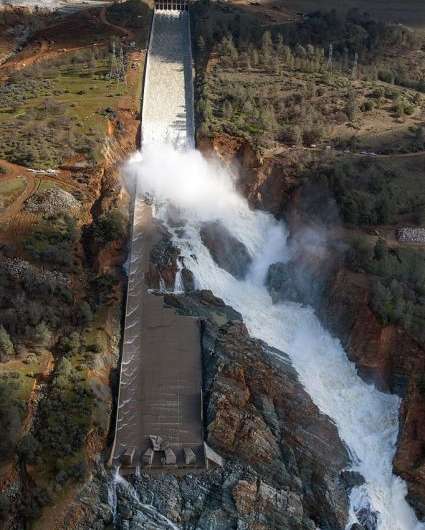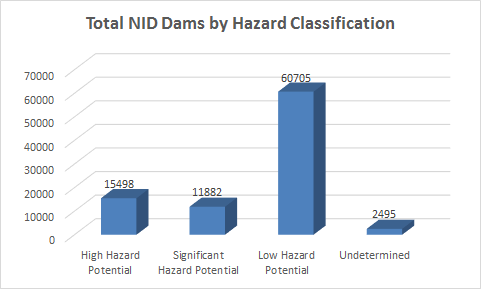America's dam crisis—was Oroville just a drop in the bucket?

Last February, record storms and snowmelt threatened to overwhelm the two spillways of California's Oroville reservoir, the tallest dam in the United States. With less than an hour's notice, nearly 200,000 people were evacuated from downstream towns and cities. In the end, emergency measures prevented a full-scale catastrophe; California officials are now working feverishly to shore up the dam before next year's rainy season.
But while the Oroville crisis has been averted for the moment, water experts at the Earth Institute's Columbia Water Center say that the near miss may be a harbinger of things to come—and not just for Oroville.
"There's a list of some 15,000 dams that are classified as 'high-hazard' in the U.S.," says Columbia Water Center Director Upmanu Lall. "What that means is that if any one of those dams fails, it could be a very big deal."
The Oroville Dam plays a key role in the California's State Water Project, which collects water from rivers in the wetter, northern part of the state and transfers them south to the heavily populated but dry areas.
Built in the mid-60s, it is, in many ways, representative of a different age, when large-scale, heroic infrastructure projects—with all of their risks and controversies—were more the norm than they are today. At the time of its construction, state officials brushed off allegations that it was being built with substandard materials.
But even as recently as 2005, environmental groups were warning that Oroville's emergency spillway was badly designed and could fail in the event of severe flooding.
According to Lall, there could be a large number of dams in a similar situation around the country. High-risk dams, he says, "are largely very old. They are prone to failure. There's been very little maintenance on them."
Lall says that while a percentage of these dams were built and are maintained by top-notch Federal agencies such as the Army Corps of Engineers, a much larger number are controlled by states or are under private ownership with little oversight.
Outdated Assumptions, Confused Issues
Part of the problem, Lall says, is that the design specifications that were used to build dams decades ago could be out of date. "Let's say those dams were designed for a 100-year event. That estimate of a 100-year event was typically based on 20 or 30 years of data, maximum. So if that data represented a dry period, that 100-year number could be more like a 10-year event. When you start subjecting these aging dams to climate variability, just like with Oroville, they'll start failing."
Lall stresses that the immediate dam crisis is not primarily related to human-caused climate change. He was, in fact, alarmed when the media narrative around the Oroville emergency quickly turned to future climate change risk, rather that focusing on the immediate infrastructure challenge. The current crisis, he says, "has nothing to do with climate change. This is about our total failure at managing risk at a basic level."
Michelle Ho, a post-doctoral research scientist at the Columbia Water Center, agrees. "There were a lot of things written about how storms like this will increase in the future. I haven't got a problem with that assessment. But the truth is that the storm that came in to fill up Lake Oroville last February wasn't actually that big. If the spillway had been working properly, there would have been no issue with the reservoir reaching the level it did. It wouldn't have made the news at all, if that spillway were in an adequate condition."

Climate change, she says, is "almost giving managers, decision makers, and policy makers a way out, an excuse for not taking action on things that can actually be fixed."
Ho was frustrated by other aspects of media coverage as well. "They would say at end of these stories that there was no structural risk," referring to the dam itself. That was technically correct, Ho says, but reading comments on the articles, she saw that residents were conflating the dam, the spillway and the auxiliary spillway. "The fact that there are three different structures obviously didn't get through to the mass public, because people were asking 'why do we have to evacuate?' That's fine, except if one of those spillways fails, you get a 30-foot wall of water coming at you. A 30-foot wall of water is not something that you want to encounter."
Ho recalls watching news accounts of the dam as the water rose. "I looked at the spillway and thought, that's a dead slope—somebody must have done some geotechnical investigation to make sure there's really solid bedrock underneath it. Of course, I found out I was wrong, and the whole thing started eroding."
The Need for a Plan
Lall and Ho agree that ultimately, the dam infrastructure issue must be connected to a broader conversation about America's water resources. After all, if the point of dams is to collect, store, or transfer water for human use, it would seem important to know how much water is actually needed in particular regions over a certain timescale—and how much water is available.
To address this challenge, Ho has been working with scientists at Columbia's Lamont-Doherty Earth Observatory to evaluate 500-year-old tree-ring data to reconstruct the history of streamflow across the United States. By understanding how streamflow has changed over the centuries, she hopes to get a better sense of how wet and dry periods have varied over long periods of time, thereby extrapolating a more accurate measure of flood and drought risk.
If anything, she says, her research suggests that a long-term pattern of drought could pose an even greater risk than flooding. "There are these long droughts that we've seen in the paleoclimate record. So we if we get hit by one of those again, our current dam infrastructure probably won't be capable of tiding us over."
But without a better assessment of what we can expect of long-term climate patterns, it may be very difficult to direct investments wisely. "If you take the assumption that it's going to be a very wet period, and you build your dam or your bridge extra high, you might be investing a whole heap of money into something that is not actually needed," she says.
Figuring out how climate has varied in the past is only part of the story, however. The other side, say Ho and Lall, is understanding how people use water—and how they are likely to use it in the future.
"Just dumping money into every structure across the U.S. is really not the way to go," says Ho. "It would be a huge waste of resources." What we need, she suggests, is a "more considered" approach.
"If we're pumping water from Northern California to Southern California over a mountain range to grow something like grass for cattle feed—it probably isn't the best use of that money. If we could have a full-cost accounting of that infrastructure, it would be equivalent to saying, 'well if you want to grow grass, you have to desalinate water.' The amount of energy you're using to grow this produce isn't really worth that much money," says Ho.
What is really needed, she says, is a national assessment of water resources and uses. "Other countries, like China, are attempting to at least get a gauge of their water resources so they can develop targets for metrics of efficient water use and productivity from water use. Basically, you put goals in place for your resource use. That's not something that America currently has.
"If you're going to talk about adapting to climate change or adapting to any change—what you really need to know is what you're currently working with. What is the current baseline risk of resource availability and resource demand for water in America? That's really not something that we have a good handle of right now."
Provided by Earth Institute, Columbia University
This story is republished courtesy of Earth Institute, Columbia University: blogs.ei.columbia.edu/ .





















